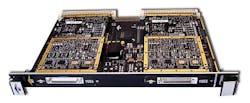Navy calls out AIT VME 1553 databus interface cards, but would consider other company offers
Officials of the Space and Naval Warfare Systems Command (SPAWAR) in San Diego announced their intention last week to award a sole-source purchase order to AIT for 10 of the company's VME 1553M-1-SP001A cards, as well as for engineering costs to add LED indicators. The value of the order has yet to be negotiated.
Although SPAWAR officials are focusing on AIT's VME-1553 boards for their test and measurement applications, they are open to offers of similar technologies from other companies, SPAWAR officials say.
Related: API for MIL-STD-1553 integrated terminal devices introduced by Holt Integrated Circuits
AIT's VME 1553 cards provide test, simulation, monitoring, and databus analyzer functions for MIL-STD- 1553A/B applications. The VME 1553 is for protocol testing and simulation of MIL-STD-1553A/B bus controller, several remote terminals, and chronological monitoring at full bus load. All operations work concurrently, and the cards provide protocol error injection and detection features with software-programmable output amplitude and bus coupling modes of the electrical bus signals.
SPAWAR is the Navy’s information-dominance systems command and technical lead for command, control, communications, computers, intelligence, surveillance, and reconnaissance (C4ISR). The command provides the hardware and software to connect warfighters.
SPAWAR provides information technology and situational-awareness capabilities to ships, aircraft and vehicles. The command supports Navy program executive offices responsible for C4I, enterprise information systems, and space systems.
Related: Radiation-tolerant dual MIL-STD-1553 interface for space applications introduced by DDC
AIT's VME 1553-1 6U VME standard board has one dual-redundant MIL-STD-1553A/B databus stream, while two, four, six, or eight independent dual-redundant MIL-STD-1553A/B databus streams are on the company's VME 1553-2, VME 1553-4, VME 1553-6, or VME 1553-8 boards.
An onboard IRIG-B time encoder and decoder enables users to synchronize single or several VME 1553 modules to a common time source. An enhanced version provides transformer or direct coupled MIL-STD-1553A/B bus connections to the bus network and the ability to manipulate output voltage levels.
Companies with products similar to the AIT VME-1553 boards and who are interested in bidding should email SPAWAR's Gerald Burch at [email protected].
Related: Lockheed Martin to replace mission computers, weather radars in C-5M cargo jets
SPAWAR officials will make a decision on either providing the order to AIT sole-source, or to compete the job based on the responses they receive. More information on this procurement is online at https://www.fbo.gov/notices/95117302dab282ca16dd95fb99f0fb68.
For more information contact Avionics Interface Technologies online at www.aviftech.com, or SPAWAR at www.spawar.navy.mil.
